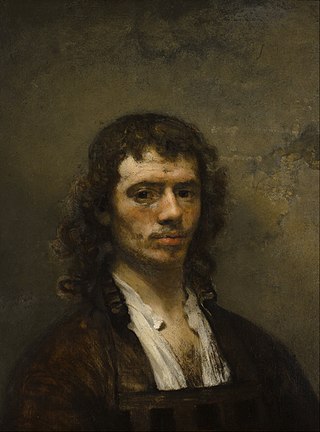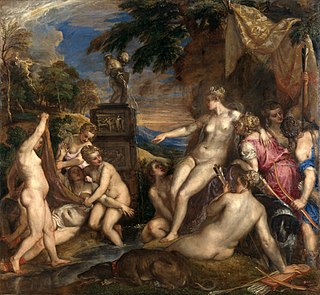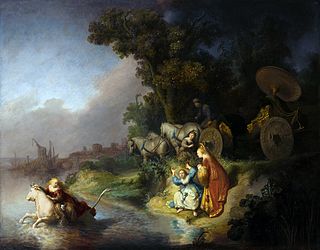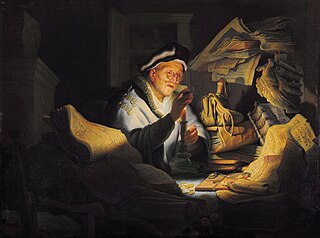
In Greek mythology, Callisto was a nymph, or the daughter of King Lycaon; the myth varies in such details. She was believed to be one of the followers of Artemis who attracted Zeus. Many versions of Callisto's story survive. According to some writers, Zeus transformed himself into the figure of Artemis to pursue Callisto, and she slept with him believing Zeus to be Artemis. She became pregnant and when this was eventually discovered, she was expelled from Artemis's group, after which a furious Hera, the wife of Zeus, transformed her into a bear, although in some versions, Artemis is the one to give her an ursine form. Later, just as she was about to be killed by her son when he was hunting, she was set among the stars as Ursa Major by Zeus. She was the bear-mother of the Arcadians, through her son Arcas by Zeus.

Carel Pietersz. Fabritius was a Dutch painter. He was a pupil of Rembrandt and worked in his studio in Amsterdam. Fabritius, who was a member of the Delft School, developed his own artistic style and experimented with perspective and lighting. Among his works are A View of Delft, The Goldfinch (1654), and The Sentry (1654).

Rembrandt Harmenszoon van Rijn, usually simply known as Rembrandt, was a Dutch Golden Age painter, printmaker, and draughtsman. An innovative and prolific master in three media, he is generally considered one of the greatest visual artists in the history of art. It is estimated Rembrandt produced a total of about three hundred paintings, three hundred etchings, and two thousand drawings.

Diana and Actaeon is a painting by the Italian Renaissance master Titian, finished in 1556–1559, and is considered amongst Titian's greatest works. It portrays the moment in which the hunter Actaeon bursts in where the goddess Diana and her nymphs are bathing. Diana is furious, and will turn Actaeon into a stag, who is then pursued and killed by his own hounds, a scene Titian later painted in his The Death of Actaeon.

The Conspiracy of Claudius Civilis is an oil painting by the Dutch painter Rembrandt, c. 1661–62, which was originally the largest he ever painted, at about five by five metres in the shape of a lunette. The painting was commissioned by the Amsterdam city council for the Town Hall. After the work had been in place briefly, it was returned to Rembrandt, who may have never been paid. Rembrandt drastically cut down the painting to a quarter of the original size to be sold. It is the last secular history painting he finished.

The National Gallery is the primary British national public art gallery, sited on Trafalgar Square, in central London. It is home to one of the world's greatest collections of Western European paintings. Founded in 1824, from an initial purchase of 36 paintings by the British Government, its collections have since grown to about 2,300 paintings by roughly 750 artists dating from the mid-13th century to 1900, most of which are on display. This page lists some of the highlights of the collection.

Diana and Callisto is a painting completed between 1556 and 1559 by the Italian late Renaissance artist Titian. It portrays the moment in which the goddess Diana discovers that her maid Callisto has become pregnant by Jupiter. The painting was jointly purchased by the National Gallery and the Scottish National Gallery for £45 million in March 2012. Along with its companion painting Diana and Actaeon it is displayed on an alternating basis between London and Edinburgh. There is a later version by Titian and his workshop in the Kunsthistorisches Museum in Vienna.

The Woman Taken in Adultery is a painting of 1644 by Rembrandt, bought by the National Gallery in London in 1824, as one of their foundation batch of paintings. It is in oil on oak, and 83.8 x 65.4 cm.

Diana and Her Companions is a painting by Dutch artist Johannes Vermeer completed in the early to mid-1650s, now at the Mauritshuis museum in The Hague. Although the exact year is unknown, the work may be the earliest painting of the artist still extant, with some art historians placing it before Christ in the House of Martha and Mary and some after.

The dozens of self-portraits by Rembrandt were an important part of his oeuvre. Rembrandt created approaching one hundred self-portraits including over forty paintings, thirty-one etchings and about seven drawings; some remain uncertain as to the identity of either the subject or the artist, or the definition of a portrait.

Rembrandt Harmenszoon van Rijn's The Abduction of Europa (1632) is one of his rare mythological subject paintings. The work is oil on a single oak panel and now located in the J. Paul Getty Museum. The inspiration for the painting is Ovid's Metamorphoses, part of which tells the tale of Zeus's seduction and capture of Europa. The painting shows a coastal scene with Europa being carried away in rough waters by a bull while her friends remain on shore with expressions of horror. Rembrandt combined his knowledge of classical literature with the interests of the patron in order to create this allegorical work. The use of an ancient myth to impart a contemporary thought and his portrayal of the scene using the High Baroque style are two strong aspects of the work.

Diana Bathing with her Nymphs with Actaeon and Callisto is a 1634 painting by the Dutch painter Rembrandt van Rijn. It is now in the Salm-Salm princely collection in the Wasserburg Anholt in Anholt, Germany.

History Painting is an early painting by Rembrandt dating to 1626. The title is a generic reference to history painting, as there is no consensus about the painting's subject matter. More than a dozen subjects have been proposed, ranging from Biblical themes to classical and modern history. Art historian Gary Schwartz says "the most tempting solution offered so far is Palamedes before Agamemnon", an episode from the Trojan War in which Agamemnon orders Palamedes stoned to death on the basis of planted evidence.

The Senses is a series of five oil paintings, completed c. 1624 or 1625 by Rembrandt, depicting the five senses. The whereabouts of one, representing the sense of taste, is unknown. Another, representing smell, was only re-identified in 2015.
Baron Willem van Dedem, also styled as Willem, Baron van Dedem, (1929–2015) was a Dutch businessman, art collector, art historian and philanthropist. He donated artworks to the National Gallery in London, the Rijksmuseum and the Mauritshuis.

The Parable of the Rich Fool, also known as The Money Changer, is an oil painting on canvas of 1627 by Rembrandt, now in the Gemäldegalerie, Berlin. Produced early in the artist's career, it depicts the eponymous Biblical parable. The model for the figure is said to have been Rembrandt's father.

The Entombment of Christ is an oil-on-oak panel painting by Rembrandt believed to be dated around c. 1624. It measures 32.2 x 40.5 cm. The composition is a variant of a painting of the same subject now in the Alte Pinakothek, in Munich.

Samson Threatening His Father-In-Law is a 1635 oil-on-canvas painting by Rembrandt, now in the Gemäldegalerie, Berlin. It depicts the Biblical story of Samson, who has returned home after an absence to find that his father-in-law has given away Samson's Philistine wife to another man. Samson's reaction was to set fire to the crops in the Philistines' fields.

Diana and Callisto is an oil-on-canvas painting by Flemish painter Paul Bril. Probably painted in the early 1620s, it was acquired by the National Gallery, London, in 1924.

Old Woman Reading, also known as Old Woman Reading a Lectionary, is an oil painting by the Dutch painter Gerrit Dou, made c. 1631–1632. In the past the work was attributed to Rembrandt and was titled Rembrandt's Mother, but this attribution has long been rejected. The portrait has been part of the collection of the Rijksmuseum, in Amsterdam, since November 1912.



















